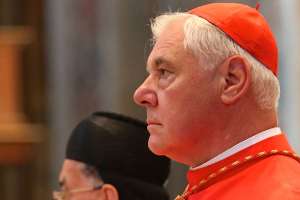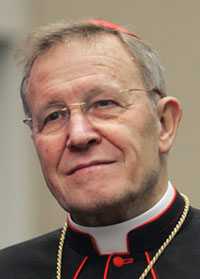 Suddenly, an increase in rumours that Cardinal Gerhard Müller is to be let go as Prefect of the Congregation for the Doctrine of the Faith appeared tonight. Should the rumours prove true, what can we say about it now?
Suddenly, an increase in rumours that Cardinal Gerhard Müller is to be let go as Prefect of the Congregation for the Doctrine of the Faith appeared tonight. Should the rumours prove true, what can we say about it now?
To be precise, the cardinal is not so much being let go or fired, but simply completes his five-year term. Cardinal Müller was appointed on 2 July 2012, so his mandate ends on Sunday. Should he not be appointed for a second mandate, it would mean that he is the first prefect to complete only one. Until 1963, the Congregation for the Doctrine of the Faith was headed by the Pope himself. After the death of Pope Saint John XXIII, Cardinal Alfredo Ottaviani was pro-prefect from 1965 to 1968, after which Cardinal Franjo Šeper served until 1981. Cardinal Joseph Ratzinger served until his fifth term, when he was elected as Pope Benedict XVI in 2005. He appointed Cardinal William Levada to succeed him: he served until 2012 (1.5 terms ended by his reaching the retirement age of 75). Cardinal Müller was then called from Regensburg to take up what is generally considered to be the first position in the Curia.
Cardinal Müller is 69, reaching the mandatory age of retirement on New Year’s Eve 2022. What is in store for him in the meantime? His name was mentioned in relation to recent vacant dioceses in Germany, especially Mainz. But the Church in Germany is currently in the luxurious position of having all its dioceses filled, and only three dioceses, Hildesheim, Fulda and Würzburg, are expected to need a new bishop within the next year. None of these are traditional cardinalatial sees, and an appointment to one of them, no matter how worthy, will be seen as a demotion of sorts. That said, to many Pope Francis is no stranger to demoting cardinals: one need only look at Cardinal Raymond Burke, who went from leading the Supreme Tribunal of the Apostolic Signatura to the largely ceremonial position of Patron of the Order of Malta. As someone on social media joked: we need more orders for all the cardinals that are being sacked… That said, the Grand Master of the Equestrian Order of the Holy Sepulchre, Cardinal Edwin O’Brien, is 78 and thus overdue for retirement…
The most interesting question of all, though, is: who has Pope Francis picked to succeed Cardinal Müller? Who will be the Holy Father’s choice to have the final say on all matters doctrinal in the Church (on behalf of the Pope, though)? Will he even pick a new prefect, or is it too far-fetched to think he may return to the pre-1963 practice of leading the Congregation for the Doctrine of the Faith himself? Stranger things have happened, after all.
When will the rumours make way for facts? It could be as early as tomorrow, so keep an eye on that Holy See press bulletin shortly after noon.
Photo credit: Lauren Cater/CNA
 I am rather surprised that articles like
I am rather surprised that articles like  Whereas a cardinal’s 80th birthday usually represent a pretty definite point beyond which he can no longer vote in a conclave, this is not so for Walter Cardinal Kasper. His 80th birthday, yesterday, fell in the sede vacante, and that means that he can still vote in the upcoming conclave. Only cardinals who mark their 80th before the See of Peter falls vacant lose that right.
Whereas a cardinal’s 80th birthday usually represent a pretty definite point beyond which he can no longer vote in a conclave, this is not so for Walter Cardinal Kasper. His 80th birthday, yesterday, fell in the sede vacante, and that means that he can still vote in the upcoming conclave. Only cardinals who mark their 80th before the See of Peter falls vacant lose that right. A fairly unseen person, Belgian prelate Frans Daneels (no relation to the similarly named Cardinal Godfried Danneels) has been noticed in Rome nonetheless. The secretary of the Supreme Tribunal of the Apostolic Signatura, the Curial body overseeing the administration of justice in the Church, has been a bishop since his appointment in 2008. Today, he was elevated to the dignity of archbishop. This makes him one of Belgium’s two active archbishops, the other of course being Archbishop Léonard.
A fairly unseen person, Belgian prelate Frans Daneels (no relation to the similarly named Cardinal Godfried Danneels) has been noticed in Rome nonetheless. The secretary of the Supreme Tribunal of the Apostolic Signatura, the Curial body overseeing the administration of justice in the Church, has been a bishop since his appointment in 2008. Today, he was elevated to the dignity of archbishop. This makes him one of Belgium’s two active archbishops, the other of course being Archbishop Léonard.
 As announced before, Raymond Cardinal Burke will be offering Mass in the Extraordinary Form on 17 September at the church of St. Agnes in Amsterdam. That day marks the fifth anniversary of the FSSP apostolate in that church.
As announced before, Raymond Cardinal Burke will be offering Mass in the Extraordinary Form on 17 September at the church of St. Agnes in Amsterdam. That day marks the fifth anniversary of the FSSP apostolate in that church.